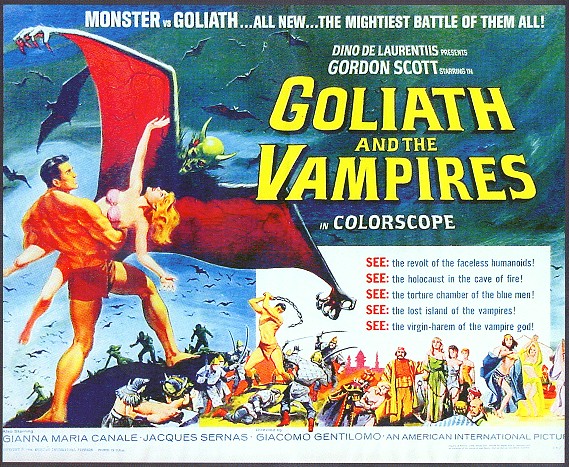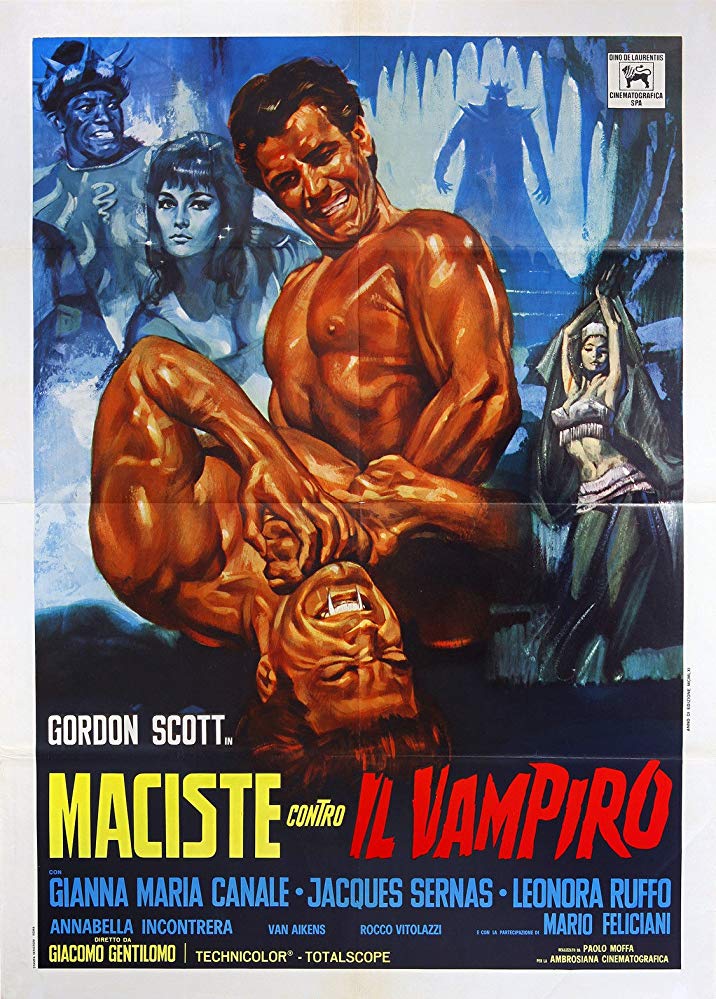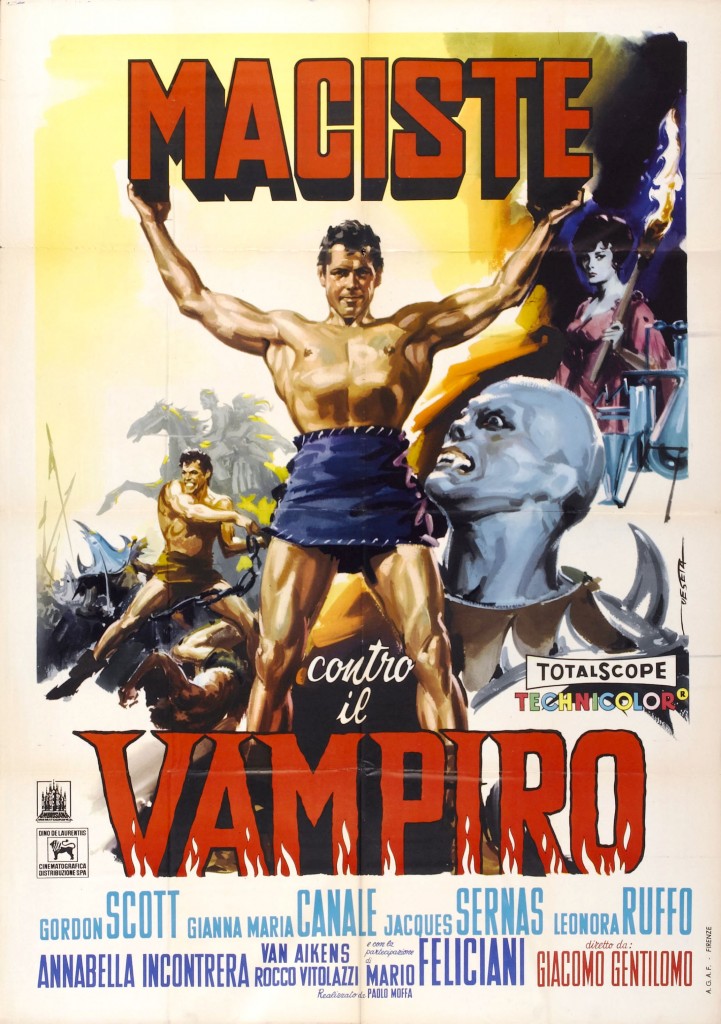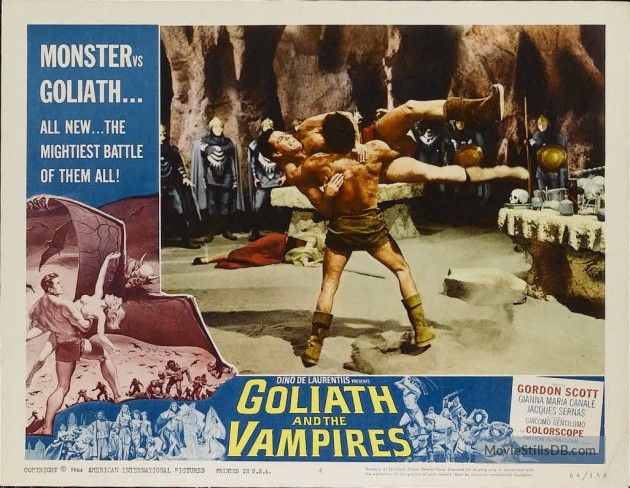Peplum Populist: Goliath and the Vampires (1961)
Okay, another Maciste film! Let’s do this!
When writing about Maciste’s history in silent movies, I promised that the next Peplum Populist article would hurtle ahead to Maciste’s first appearance in the sword-and-sandal boom of the 1960s, Son of Samson (Maciste nella valle dei Re). But I have a DVD of Goliath and the Vampires (Maciste contro il vampiro) lying here on the shelf, and it’s about time I completed the “dark fantasy” trio of peplum classics after writing about Hercules in the Haunted World (1961) and Maciste in Hell/The Witch’s Curse (1962). Although Goliath and the Vampires doesn’t have the same visual imagination, it’s in the 90th percentile as far as sword-and-sandal fun goes.
Goliath and the Vampires features more stock genre situations than those two other films. The fantastic elements don’t dictate the story as much as they’re pasted onto the pre-fabricated framework of what sword-and-sandal films were quickly solidifying into.
Until the fantasy-horror aura settles in during the last twenty minutes, Goliath and the Vampires is a “greatest hits” of the muscleman film. Might as well just bullet point ‘em:
- Open with a village raid.
- Hero goes on a quest with a sidekick.
- A big fight in a town square.
- A brawl in a tavern.
- A manipulating evil queen/femme fatale.
- Strange execution method.
- Endurance test for the hero (the same one from The Colossus of Rhodes, torture by gonging a bell).
- A ceremonial dance number.
- A second ceremonial dance number.
- Trap doors.
- Nets that immobilize the hero instantly.
 It’s all here — and thankfully good examples of the form. (Except the net, a lazy shortcut every time it pops up.) In fact, Goliath and the Vampires is more adept at the standard action scenes than Hercules in the Haunted World, where Mario Bava didn’t show much interest in staging beefcake battles.
It’s all here — and thankfully good examples of the form. (Except the net, a lazy shortcut every time it pops up.) In fact, Goliath and the Vampires is more adept at the standard action scenes than Hercules in the Haunted World, where Mario Bava didn’t show much interest in staging beefcake battles.
Aside from the dark fantasy elements, the best change the movie makes to the peplum formula is a finale where the villain assumes the shape of the hero. Instead of a boilerplate sweaty wrestling match, we close out on a Maciste vs. Maciste sweaty wrestling match.
Maciste (Gordon Scott) is handled differently than usual for the 1960s. He’s no longer a perpetual wanderer but has instead settled down. He lives in a village with his mother and is betrothed to the beautiful Guja (Leonora Ruffo). Of course, his village is the one raiders sack in the opening, Maciste’s mother dies, and Guja is kidnapped to give Maciste a reason to go a’ questing. This isn’t the fixed Maciste plot, where he walks into somebody else’s problem, selflessly helps out, then moves on. But I’d be lying if I said this change in the character bothers me. It’s Maciste. He can be whatever the filmmakers want him to be. And the dubbing keeps calling him “Goliath,” so I can flow with it.
Maciste’s quest to rescue Guja takes him to the city of Salmanak, designed in a Thief of Bagdad Arabian fantasy style. The Sultan of Salmanak (Mario Feliciani) is under the control of the vampire lord Kobrak and his seductive agent, the sultry Astra (Gianna Maria Canale, who played the Amazon queen in Hercules and was no stranger to sultry). Maciste finds help from Kurtik (Jacques Sernas), the leader of the race of Blue Men who are Kobrak’s ancient foes. Kobrak wants to use Maciste’s body as a model for his conquering army of blood slaves and hopes Guja will lure the strongman to his mountain hideout. Kurtik comes through with some chemical magic, Astra switches allegiance to help Maciste survive the bell trap, Maciste rips off Kobrak’s face, Kobrak blows up, and all ends well — except the poor kid sidekick Ciro (Rocco Vidolazzi) dies and nobody seems to notice. At least Ciro wasn’t an annoying little sidekick.
 Despite the title, there are no traditional vampires here. Kobrak is the closest we get: an immortal sorcerer dressed head-to-toe in armor that makes him look like a Pac-Man ghost. (Clyde, I think.) Kobrak’s backstory is muddled. The most we learn is that he’s “a beast who sprung from a serpent born in the depths of the kingdom of evil” and nourishes himself on blood. But even though we see Kobrak with fangs at the climax, he never does anything vampiric on screen. He has his henchmen steal blood from captives, which he then uses to create blood automatons, or “robots” as the English dub anachronistically calls them. The blood automatons are more akin to zombies than vampires.
Despite the title, there are no traditional vampires here. Kobrak is the closest we get: an immortal sorcerer dressed head-to-toe in armor that makes him look like a Pac-Man ghost. (Clyde, I think.) Kobrak’s backstory is muddled. The most we learn is that he’s “a beast who sprung from a serpent born in the depths of the kingdom of evil” and nourishes himself on blood. But even though we see Kobrak with fangs at the climax, he never does anything vampiric on screen. He has his henchmen steal blood from captives, which he then uses to create blood automatons, or “robots” as the English dub anachronistically calls them. The blood automatons are more akin to zombies than vampires.
These blood zombies only menace Maciste during the finale, and the rest of the time our hero clobbers incompetent guards. Dozens and dozens of them. Waves of stupid, stupid guards. I’ve never seen a peplum movie with more useless supernumeraries getting hammered. Dressed in padded beige tunics covered with metal studs, the guards of the city of Salmanak make a concerted effort always to charge Maciste in organized formations so whatever weapon he’s using (chain, bench, statue, platform of spikes) will smash all of them at once. Don’t misunderstand: this is great fun. It’s also hilarious.
The Double Maciste showdown is the main reason to show up. I’ve mentioned how the true test for a peplum when it comes it entertainment is if it has that one scene that goes beyond the call of duty to be strange or over-the-top. Watching Gordon Scott wrestle Gordon Scott is where Goliath and the Vampires pulls off its showstopper, even with all the fantasy elements before it. The illusion of two Gordon Scotts is close to perfect. There are only brief moments when you can see the stunt double, who’s physically an ideal match for Scott. The slick editing, choreography, and camera angles disguise the trickery so well that suspending disbelief is easy. It’s no small feat to create an exciting one-on-one fight while trying to work around a stunt-double who must be in almost every shot.
The double for Scott in the showdown isn’t credited, but according to the fansite PeplumTV, it’s probably Giovanni Cianfriglia, who was the stunt double for Steve Reeves in Hercules. Kobrak in his armored form is credited as Guido Celano, but the English voice actor and the costume yanked off the cover of an ‘80s heavy metal album handle the heavy performance work. Kobrak’s appearance is the perfect mixture of goofy and fabulous.
After Steve Reeves, Gordon Scott is my favorite sword-and-sandal actor. He never got to dub his own voice in these films, unlike in the Tarzan movies, but he knew more about acting by the time he put on the sword-and-sandal tunic than most other musclemen performers. Working as Tarzan for a few years can do that for you. This is arguably the best of Gordon Scott’s many peplum movies.
 Another performance worth mentioning is Vanoye “Van” Aikens as Amahil, chief of Kobrak’s warriors and the leader of the raiding party. Aikens was born in Georgia and became a member of the Katherine Dunham Dance Company, the first African-American dance company. Aikens was a founding member in 1943 and toured the world as part of the troupe. When the company disbanded in 1963, Aikens did a stint as an actor in Europe. It’s unfortunate he didn’t have more film roles, and I wish his role here was bigger because his physical presence and movement demand attention. Thankfully, Aikens stayed active in dance into his nineties and died in 2013 at age ninety-six. I can’t imagine he had many regrets.
Another performance worth mentioning is Vanoye “Van” Aikens as Amahil, chief of Kobrak’s warriors and the leader of the raiding party. Aikens was born in Georgia and became a member of the Katherine Dunham Dance Company, the first African-American dance company. Aikens was a founding member in 1943 and toured the world as part of the troupe. When the company disbanded in 1963, Aikens did a stint as an actor in Europe. It’s unfortunate he didn’t have more film roles, and I wish his role here was bigger because his physical presence and movement demand attention. Thankfully, Aikens stayed active in dance into his nineties and died in 2013 at age ninety-six. I can’t imagine he had many regrets.
Basic storytelling isn’t one of the strengths of sword-and-sandal films, and Goliath and the Vampires contains a few baffling turns. The intriguing mythology of Kobrak is hurried through when the character Magda (another kidnapped girl) reads it from a book in Kurtik’s laboratory. Madga then dies abruptly and the mythology is never brought up again. Ciro dies a painful death after getting wounded in the swamp fight with Kobrak’s zombies, but instead of dying with Maciste at his side, he flails about believing Kurtik is Maciste. What does Maciste think when he later hears about the death of his young sidekick? Nothing — at least as far as we know, since Ciro’s death isn’t mentioned to him on screen. The film hops right to the cheerful coda with Maciste and Guja waving to an adoring crowd with not a moment of mourning for the boy’s sacrifice.
Then there’s a mystifying plot jump where Guja and Astra escape together from a cavern between scenes without explanation. When they next appear, they’re miles from where they were and Astra has turned on Guja and manacled her. I suspect this confusion may be from the U.S. distributor making clumsy edits. Peplum films often suffered from butchering cuts, with multiple running times in different countries.
Giacomo Gentilomo is the credited director, with an unidentified amount of input from Italian Western great Sergio Corbucci (Django, The Great Silence), who co-wrote the screenplay. Apparently, Corbucci’s role in the direction was limited. There certainly isn’t much of his hyperactivity and jumpy style evident, although the unexplained plot lurches might his doing. Gentilomo was reaching the end of a career that started in pre-war Italy. He helmed a few other peplum, including the MST3K classic Hercules Against the Moon Men, which is — surprise! — actually a Maciste film: Maciste e la regina di Samar (Maciste and the Queen of Samar). There’s another fantasy film on Gentilomo’s filmography, The Dragon’s Blood (aka Sigfrido), a 1957 take on Der Ring des Nibelungen with special effects by Carlo Rambaldi. I’d love to dig up a copy of this, but my search efforts have yielded nothing.
Goliath and the Vampires is available on DVD in North America from Something Sinister video, packaged with the unrelated Steve Reeves historical epic Goliath and the Barbarians (1958). Both films are presented in their original aspect ratio. Unfortunately, neither is enhanced for widescreen televisions. The print for Goliath and the Vampire has faded to the point where underground sets look like they were shot in monochrome sepia, and there’s copious print damage that almost drowns the images during the scenes in the swamp. Sad to say, this presentation is still better than three-quarters of the other sword-and-sandal films I’ve watched. Next week we’re finally getting a Blu-ray release of a classic peplum film — The Colossus of Rhodes (yeah!) from Warner Archive — so there’s hope yet for quality releases of films like this. A Blu-ray package of the “horror trilogy” of Goliath and the Vampires, Hercules in the Haunted World, and Maciste in Hell is something a boutique video label should consider. But if it took this long to get even one Italian sword-and-sandal film on Blu-ray … I’m not raising my hopes.
Speaking of Blu-rays and Sergio Corbucci, The Great Silence, Corbucci’s best film, was released last week on Blu-ray. I’ll take a look at that next time. Warning: it’s really really really depressing.
Ryan Harvey is one of the original bloggers for Black Gate, starting in 2008. He received the Writers of the Future Award for his short story “An Acolyte of Black Spires,” and his stories “The Sorrowless Thief” and “Stand at Dubun-Geb” are available in Black Gate online fiction. A further Ahn-Tarqa adventure, “Farewell to Tyrn”, is available as an e-book. His most recent publication, “The Invasion Will Be Alphabetized,” is now on sale in Stupendous Stories #19. Ryan lives in Costa Mesa, California where he works as a marketing writer. Occasionally, people ask him to talk about Edgar Rice Burroughs or Godzilla in interviews.
